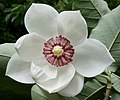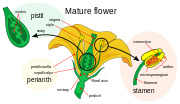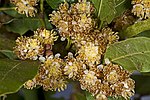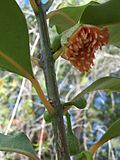Amborella is a monotypic genus of understory shrubs or small trees endemic to the main island, Grande Terre, of New Caledonia in the southwest Pacific...
27 KB (2,858 words) - 18:11, 25 October 2024
most basal angiosperms were called the ANITA grade, which is made up of Amborella (a single species of shrub from New Caledonia), Nymphaeales (water lilies...
7 KB (654 words) - 18:28, 27 July 2024
to set fruit and produce berries, this has consequences for gardeners. Amborella represents the first known group of flowering plants to separate from...
29 KB (2,959 words) - 21:44, 29 October 2024
Amborellaceae, and there is only one genus, Amborella, and in this genus there is only one species, Amborella trichopoda. The flowering plant Breonadia...
14 KB (1,578 words) - 06:21, 18 November 2024
does indeed correlate with an unusual number of ancestral traits, as in Amborella (see below). This is likely a source of the mis-use of the term. Other...
36 KB (3,963 words) - 14:36, 23 September 2024
"Reconstructing the ancestral female gametophyte of angiosperms: Insights from Amborella and other ancient lineages of flowering plants". American Journal of Botany...
80 KB (6,328 words) - 06:14, 11 November 2024
million years ago. Recent DNA analysis (molecular systematics) shows that Amborella trichopoda, found on the Pacific island of New Caledonia, is the only...
103 KB (11,623 words) - 12:22, 8 November 2024
flowering plants near the base of the flowering plant lineage, such as Amborella and Nymphaea (as well as with many more recently derived plants, such...
47 KB (5,076 words) - 23:35, 10 November 2024
Caledonia also has the world's most divergent lineage of flowering plant, Amborella trichopoda, which is at, or near, the base of the clade of all flowering...
149 KB (13,006 words) - 03:27, 18 November 2024
most inclusive crown clade containing Platanus occidentalis, but not Amborella trichopoda, Nymphaea odorata, or Austrobaileya scandens. It is sometimes...
11 KB (1,173 words) - 06:36, 19 September 2024
believed to be the ancestral condition in flowering plants. For example, Amborella, which is thought to have separated earliest in the evolution of flowering...
6 KB (670 words) - 09:43, 24 October 2024
Abnormally small 4 celled, 4 nucleate angiosperm female gametophyte (ex. Amborella trichopoda). E: Unusual gymnosperm female gametophyte that is singled...
26 KB (3,151 words) - 05:27, 23 August 2024
the distantly related sunbittern of South America, and plants such as Amborella trichopoda, the only known member of the most basal living branch of flowering...
41 KB (3,618 words) - 08:43, 24 October 2024
older, that being the woody New Caledonian shrub Amborella trichopoda. The predominant view that Amborella represents the oldest flowering plant was recently...
11 KB (1,110 words) - 22:33, 18 November 2024
Spermatophytes Clade: Angiosperms Groups included Eudicots Magnoliids Amborella Nymphaeales Austrobaileyales Chloranthales Ceratophyllum Cladistically...
14 KB (784 words) - 08:32, 22 September 2024
the source of nutmeg, was important in the 17th-century spice trade. Amborella may represent the earliest-diverging order of flowering plants. From the...
41 KB (2,118 words) - 20:56, 4 March 2024
During some or all of the 20th century, the Laurales generally included Amborella and the plants now classified in Austrobaileyales and Chloranthaceae....
7 KB (590 words) - 20:52, 13 July 2024
Nymphaeales, which is the second diverging group of angiosperms after Amborella in the most widely accepted flowering plant classification system, APG...
26 KB (2,690 words) - 16:31, 25 October 2024
flowering plants called basal angiosperms or paleodicots; these include Amborella, Magnolia, nutmeg and avocado, while trees such as bamboo, palms and bananas...
124 KB (12,853 words) - 11:49, 17 November 2024
wood. Tension wood may have as high as 60% cellulose. In gymnosperms and amborella it is called compression wood. Compression wood forms on the side of the...
5 KB (659 words) - 18:28, 26 September 2024
multiple lines of evidence Ginkgo tree (Ginkgoaceae) Welwitschia Angiosperms Amborella – a plant from New Caledonia, possibly closest to base of the flowering...
48 KB (4,995 words) - 05:28, 4 November 2024
event was studied by sequencing the genome of an ancient flowering plant, Amborella trichopoda. Many paleobotanists consider the Caytoniales, a group of "seed...
27 KB (2,890 words) - 22:22, 26 September 2024
(Cyathea novae-caledoniae), or the tallest in the world, Cyathea intermedia. Amborella has emerged as of great interest to plant systematists because molecular...
50 KB (5,874 words) - 21:26, 17 November 2024
doi:10.1038/ncomms16047. PMC 5543309. PMID 28763051. Amborella Genome Project (20 Dec 2013). "The Amborella Genome and the Evolution of Flowering Plants". Science...
140 KB (17,348 words) - 23:49, 15 November 2024
discussion of the family. Perkins defined the family very broadly, to include Amborella, Trimenia, and Piptocalyx. These are now regarded as basal angiosperms...
43 KB (3,592 words) - 13:25, 21 July 2024
Greek shepherdess from classical poetry Asparagales CS Amborellaceae Amborella – Malagasy plant name Amborellales Anacampserotaceae Anacampseros G Greek...
80 KB (2,399 words) - 02:04, 11 January 2024
1534/g3.119.400083. PMC 6643874. PMID 31217262. Amborella Genome Project (December 2013). "The Amborella genome and the evolution of flowering plants"....
173 KB (10,364 words) - 15:01, 25 September 2024
rose as well as preliminary work on the origin of flowering plants using Amborella trichopoda-core species of all current flowering plants endemic to New...
12 KB (1,488 words) - 14:54, 10 June 2024























